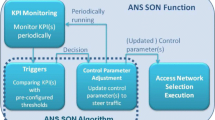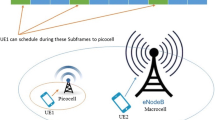Abstract
3GPP long term evolution (LTE) is a promising candidate for the next-generation wireless network, which is expected to achieve high spectrum efficiency by using advanced physical layer techniques and flat network structures. However, the LTE network still faces the problem of load imbalance as in GSM/WCDMA networks, and this may cause significant deterioration of system performance. To deal with this problem, mobility load balancing (MLB) has been proposed as an important use case in 3GPP self-organizing network (SON), in which the serving cell of a user can be selected to achieve load balancing rather than act as the cell with the maximum received power. Furthermore, the LTE network aims to serve users with different quality-of-service (QoS) requirements, and the network-wide objective function for load balancing is distinct for different kinds of users. Thus, in this paper, a unified algorithm is proposed for MLB in the LTE network. The load balancing problem is first formulated as an optimization problem with the optimizing variables being cell-user connections. Then the complexity and overhead of the optimal solution is analyzed and a practical and distributed algorithm is given. After that, the proposed algorithm is evaluated for users with different kinds of QoS requirements, i.e., guaranteed bit rate (GBR) users with the objective function of load balance index and non-GBR (nGBR) users with the objective function of total utility, respectively. Simulation results show that the proposed algorithm leads to significantly balanced load distribution for GBR users to decrease the new call blocking rate, and for nGBR users to improve the cell-edge throughput at the cost of only slight deterioration of total throughput.
Similar content being viewed by others
References
3GPP. Evolved Universal Terrestrial Radio Access (E-UTRA); LTE physical layer; General description (Release 10). 3GPP TS 36.201. 2010
3GPP. Evolved Universal Terrestrial Radio Access Network (E-UTRAN); Architecture description (Release 10). 3GPP TS 36.401. 2011
Sesia S, Toufik I, Baker M. LTE, the UMTS Long Term Evolution: from Theory to Practice. John Wiley & Sons, 2011
Tolli A, Barbancho I, Gomez J, et al. Intra-system load balancing between adjacent GSM cells. In: Proceedings of IEEE Vehicular Technology Conference, Jeju, 2003. 393–397
Du L, Bigham J, Cuthbert L. Geographic load balancing for WCDMA mobile networks using a bubble oscillation algorithm. In: Proceedings of IEEE Wireless Communications and Networking Conference, New Orleans, 2005. 1714–1719
Zhu H, Buot T, Nagaike R, et al. Load balancing in WCDMA systems by adjusting pilot power. In: Proceedings of the 5th International Symposium on Wireless Personal Multimedia Communications, Hawaii, 2002. 936–940
3GPP. Evolved Universal Terrestrial Radio Access Network (E-UTRAN); Self-configuring and self-optimizing network (SON) use cases and solutions (Release 9). 3GPP TR 36.902. 2011
Hanly S V. An algorithm for combined cell-site selection and power control to maximize cellular spread spectrum capacity. IEEE J Sel Areas Commun, 1995, 13: 1332–1340
Bejerano Y, Han S. Cell breathing techniques for load balancing in wireless lans. In: Proceedings of 25th IEEE International Conference on Computer Communications, Barcelona, 2006. 1–13
Kwan R, Arnott R, Paterson R, et al. On mobility load balancing for LTE systems. In: Proceedings of IEEE Vehicular Technology Conference, Ottawa, 2010. 1–5
Suga J, Kojima Y, Okuda M. Centralized mobility load balancing scheme in LTE systems. In: Proceedings of the 8th International Symposium on Wireless Communication Systems, Aachen, 2011. 306–310
Wei Y, Peng M. A mobility load balancing optimization method for hybrid architecture in self-organizing network. In: Proceedings of IET International Conference on Communication Technology and Application, Beijing, 2011. 828–832
Katzela I, Naghshineh M. Channel assignment schemes for cellular mobile telecommunication systems: a comprehensive survey. IEEE Commun Surv Tutor, 2000, 3: 10–31
Son K, Chong S, Veciana G. Dynamic association for load balancing and interference avoidance in multi-cell networks. IEEE Trans Wirel Commun, 2009, 8: 3566–3576
Wang H, Ding L, Wu P, et al. Dynamic load balancing and throughput optimization in 3GPP LTE networks. In: Proceedings of the 6th International Wireless Communications and Mobile Computing Conference. New York: ACM, 2010. 939–943
Sang A, Wang X, Madihian M, et al. Coordinated load balancing, handoff/cell-site selection, and scheduling in multicell packet data systems. Wirel Netw, 2008, 14: 103–120
Bu T, Li L, Ramjee R. Generalized proportional fair scheduling in third generation wireless data networks. In: Proceedings of the 25th IEEE International Conference on Computer Communications, Barcelona, 2006. 1–12
3GPP. Technical Specification Group Services and System Aspects; Policy and charging control architecture (Release 11). 3GPP TS 23.203. 2012
3GPP. Technical Specification Group Radio Access Network; Evolved Universal Terrestrial Radio Access Network (E-UTRAN); X2 general aspects and principles (Release 10). 3GPP TS 36.420. 2011
Jain R, Chiu D, Hawe W. A quantitative measure of fairness and discrimination for resource allocation in shared systems. Technical Report DEC-TR-301, Digital Equipment Corporation, 1984
Chiang M, Low S, Calderbank A, et al. Layering as optimization decomposition. Proc IEEE, 2007, 95: 255–312
3GPP. Technical Specification Group Radio Access Network; Physical layer aspects for evolved Universal Terrestrial Radio Access (UTRA) (Release 7). 3GPP TR 25.814. 2006
Kim S J, Wang X. Hierarchical approach to interference mitigation in multi-cell downlink orthogonal frequency-division multiple-access networks with low feedback. IET Commun, 2011, 5: 660–666
Marler R T, Arora J S. Survey of multi-objective optimization methods for engineering. Struct Multidiscip Optim, 2004, 26: 369–395
Marler R T, Arora J S. The weighted sum method for multi-objective optimization: new insights. Struct Multidiscip Optim, 2010, 41: 853–862
Author information
Authors and Affiliations
Corresponding author
Rights and permissions
About this article
Cite this article
Wang, H., Liu, N., Li, Z. et al. A unified algorithm for mobility load balancing in 3GPP LTE multi-cell networks. Sci. China Inf. Sci. 56, 1–11 (2013). https://doi.org/10.1007/s11432-012-4769-2
Received:
Accepted:
Published:
Issue Date:
DOI: https://doi.org/10.1007/s11432-012-4769-2




